Dental decay (caries) is a common condition affecting preschool children in Western Australia (WA)1. Decay has been reported as the fifth most common cause of hospitalisation for preschool children in WA2, with rural preschool children being 1.3 times more likely to be hospitalised for decay than their metropolitan counterparts2. Most of the children living in rural and remote areas of WA do not access a dental service before the year in which they turn 5 years of age, when all children in WA become eligible to register with the publically funded School Dental Service program1.
According to previous data from WA, only 5% of children attend a dental service before they start school3. Although the reasons for the late age of first dental visit in pre-school children are not known, many factors such as cost, access issues and lack of awareness on the part of parents are believed to contribute to the problem. Although there is very little published data concerning the oral health issues of Australian preschool children, similar trends in late age of first dental visit have been reported in other studies from other Australian states4,5. Access issues have been previously reported as a reason for the low rate of dental care for children living in remote communities such as those in the Kimberley and Pilbara regions of WA6. Although the prevalence of dental decay has decreased in Australia in past years, significant variations are known to exist among children in different geographic locations3.
Low socioeconomic status and Indigenous and ethnic backgrounds have been reported as independent risk factors for decay3,7-9. The present study examined the prevalence and severity of decay in preschool children in several regions of rural and remote WA and considered some of the factors associated with these rates.
Ethics approval was obtained from the Ethics Committee of The University of Western Australia. This study was a retrospective cross-sectional analysis of oral health data from preschool children aged 2-4 years, within five rural and remote communities in WA. The survey sample was an opportunistic sample collected during provision of visiting oral health services for the communities of Carnarvon, Wiluna, Roebourne, Kalgoorlie and Esperance. Children were examined as a structured process within pre-schools and on an opportunistic basis within Aboriginal Health Services. The pre-school aged child population (census 2006) of these places is presented (Table 1)10.
Each child's parent/caregiver completed a short questionnaire regarding aspects of the child's dental and medical histories, diet, infant feeding patterns and dental hygiene practices. A dentist examined each child using a mouth mirror and dental light or torch light with the support of an assistant and with access to documented procedures for examination. Children were examined lying in a lap-to-lap position or seated facing the examiner. World Health Organisation (WHO) criteria were used to diagnose dental caries. Four examiners were used, all of whom were trained to follow the WHO guidelines during examinations11.
Decay experience, expressed as a dmft score1, the commonly accepted and widely used epidemiological measure of decay experience in children's teeth was assessed in this study. It represents the total mouth count of deciduous teeth affected by decay and includes teeth with untreated decay (d), teeth missing as a result of decay (m) and decayed teeth which have been treated with fillings (f). In this study, to be consistent with other previous studies, the carious involvement of two or more upper front (maxillary anterior) teeth was the diagnostic criteria applied for severe early childhood caries (s-ECC)1.
All data analysis for the present study was completed using SPSS v16 (www.spss.com).
There were 253 participants (15% of the total preschool population in the communities involved). Two-thirds of the children involved in the study were non-Indigenous (n=174, 69%) and one-third identified as Aboriginal or Torres Strait Islander (Indigenous, n=79, 31%); Table 1. More than one-third of the children (n=98, 39%) had teeth affected by decay.
Table 1: Sample size and population data for the residential locations of Indigenous and
non-Indigenous children. It is evident that the highly mobile population associated
with Wiluna (as measured at the census10) does not represent the children present at the time of review
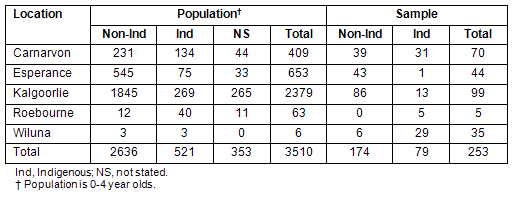
Dental history
Overall, 13% (n=34) of the children had suffered toothache at some time and 16% (n=41) had previously attended a dental service (Table 2).
Toothache was more commonly experienced among the Indigenous children (30% of Indigenous children had suffered toothache compared with 7% of the non-Indigenous children); Table 3.
Overall 15% of children (n=37) did not have a toothbrush at home at the time of the study and 25% (n=64) never brushed their teeth or did so less than once daily (Table 2).
In comparison with the non-Indigenous children, less Indigenous children had toothbrushes (62% vs 97%), less brushed at least once daily (50% vs 84%) and more had never brushed at all (33% vs 2%); Table 4. The mean number of decayed, missing or filled teeth (dmft) of those who never brushed (2.7, standard deviation [sd] 3.1) was statistically higher (p<0.05, χ2) than for those who brushed once daily (1.39, sd 2.7) and those who brushed twice daily (1.36, sd 2.6).
Table 2: Patient parent/guardian reported outcomes for the total population
and for those who are suffering some level of decay (ie dmft >0)
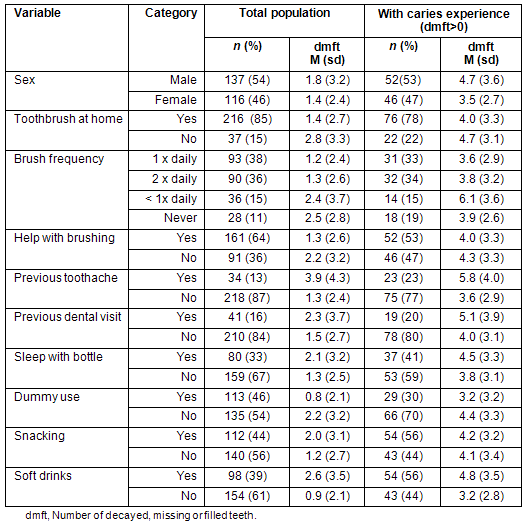
Table 3: The mean number of decayed, missing or filled teeth and the
proportion of this index contributed by untreated decay for Indigenous
and non-Indigenous children in the data frameset
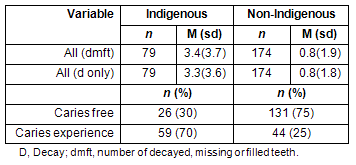
Table 4: A comparison of reported behaviours and toothache history
between the total study population and those with severe early childhood caries
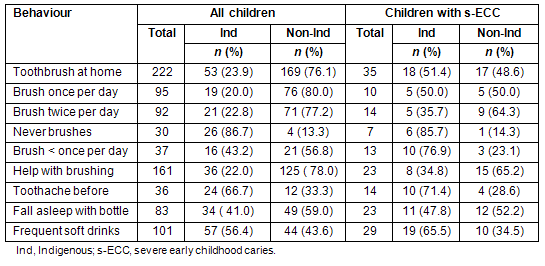
Bottle and dummy use
Approximately one-third of children fell asleep with a feeding bottle in their mouth (mostly reported to contain milk). The rate of this practice was not significantly different in children with and without decay. Dummy use was common among non-Indigenous children (86%) and very uncommon among Indigenous children (14%) (Table 2).
Diet
More than one-third of children (39%) consumed soft drink; however, in the group of children suffering from decay, this increased significantly (p<0.05, χ2) to 56%.
Oral health status
More than one-third (39%) of children had teeth affected by decay (dmft >0) with no significant difference in decay levels between males and females (Table 2). Most children with decay had several teeth affected (Fig 1), and more than 85% of these children had teeth with untreated decay (Table 3). The specific diagnosis of s-ECC applied to 18% of the overall group of children and the average dmft among this group was 6.4 (sd=3.4). This condition was more common among the Indigenous children (n=27, 34% vs n=18, 10% for non-Indigenous children) and occurred in more than half of children who had suffered toothache (58%) and half of those reporting frequent soft drink intake (51%).
A depiction of the wide variation in dmft scores and an analysis of this distribution according to Indigenous status is provided (Fig1). Whereas 75% of non-Indigenous children had no decay, only 25% of Indigenous were disease-free, and Indigenous children were increasingly disproportionately represented at all disease levels exceeding dmft = 1.
Overall the dmft scores for children suffering decay were higher for Indigenous children, those who did not have toothbrushes at home, those who had experienced toothache previously, and those who frequently consumed soft drinks (Table 1).
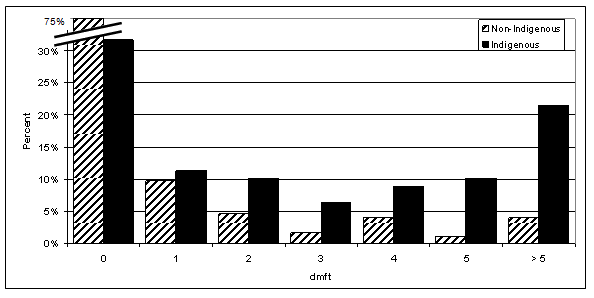
Figure 1: Percentage of Indigenous and non-Indigenous children according to dmft
(number of decayed, missing or filled teeth) score. dmft = 0 for non-Indigenous children was 75%.
Discussion
The study results clearly demonstrate that poor preschooler oral health is prevalent in some Indigenous communities in rural and remote areas of WA. Water fluoridation levels in the communities concerned varies between 0.3-0.9 ppm, which indicates suboptimal levels in some communities. Due to small community sizes however, water fluoridation is not a feasible option and this highlights the potential value of fluoridated toothpaste use in such communities.
Although the study has some limitations - retrospective, opportunistic sample design without assessment of socioeconomic background, and the well-known complexities of the questionnaire process - it makes a significant contribution to knowledge in an area of little published data.
In this study, untreated caries (d) comprised the overwhelming majority of the average dmft of 1.7 score, with an average d=1.6 (sd=2.8), m=0.2 (sd=0.7), and f=0.1 (sd=0.4). The mean dmft score of 1.7 is consistent with that reported in a study carried out among preschool children in Brisbane (metropolitan Queensland, Australia) where the dmft score was 1.48,9. The mean dmft score is less than the score reported in our previous study of a similar rural population1; however, this study included some significantly more remote Indigenous communities. The proportion of decay-free children of approximately 60% is similar to the number determined by previous surveys3,7. Although the decay severity reported in this study for Indigenous children is higher than that reported in previous studies12-17, the disparity in mean dmft between Indigenous and non-Indigenous children is consistent with previous studies1,13,14.
The mean dmft score in this study was less than that reported in the Child Dental Health Survey (CDHS) of WA for 5-6 year-old children3. This is not unexpected because participants were older in the CHDS, there was less geographic clustering and fewer problems obtaining representative samples. Severe early childhood caries was significantly associated with Indigenous status, consumption of carbonated drinks, toothache history and sleeping with a feeding bottle. The factors associated with s-ECC in this study are consistent with previous research18-22.
Little published research has focused on the oral health of rural and remote Australian preschool children. Although the number of participants in the present study was small and opportunistic sampling techniques were utilized, it is among the largest in the area and one of the first in Australia. Knowledge and recognition of oral health disparities and treatment needs are the first steps in addressing the very complex issues involved. This study found a significant burden of unmet need in the children examined, representing a significant level of pain and suffering in this group. This suffering is greater for Indigenous children. Action to improve this serious situation is linked with promoting the core messages for good oral health. A systemic approach to addressing the needs of remote dwelling people, and in particular remote area Indigenous children, must include a sustained evidence-based, primary health focus that is inclusive of oral health. Included in this approach are efforts to address rural inequities in the social determinants of health, promote a healthy lifestyle and improve accessibility to primary health care.
References
1. Kruger E, Dyson K, Tennant M. Pre-school child oral health in rural Western Australia. Australian Dental Journal 2005; 50(4): 258-262.
2. Kruger E, Dyson K, Tennant M. Hospitalization of Western Australian children for oral health related conditions: a 5-8 year follow-up. Australian Dental Journal 2006; 51(3): 231-236.
3. AIHW Dental Statistics and Research Unit. Child Dental Health Survey, Western Australia 2002. 2006; AIHW Cat. no. DEN 160. Adelaide, SA: The University of Adelaide, 2006.
4. Gussy MG. A qualitative study exploring barriers to a model of shared care for pre-school children's oral health. British Dental Journal 2006; 201(3): 165-170.
5. Ellershaw A, Spencer AJ, Slade GD. Oral health in South Australia 2004. AIHW Population Oral Health Series 4. Cat no. POH4. Canberra, ACT: Australian Institute of Health and Welfare, 2005.
6. Tennant M, Namjoshi D, Silva D, Codde J. Oral Health and hospitalization in Western Australian children. Australian Dental Journal 2000; 45(3): 204-207.
7. Armfield JM, Spencer AJ. Socioeconomic differences in children's dental health. In: The Child Dental Health Survey, Australia 2001. AIHW Dental statistics and Research Series 35. Cat. no. DEN 152. Canberra, ACT: Australian Institute of Health and Welfare, 2006.
8. Hallett KB. Dental caries experience of preschool children from the north Brisbane region. Australian Dental Journal 2002; 47(4): 331-338.
9. Hallett KB. Social and behavioural determinants of early childhood caries. Australian Dental Journal 2003; 48(1): 27-33.
10. Australian Bureau of Statistics 2006 Census. Community profiles by location. Canberra, ACT: Australian Bureau of Statistics, 2006.
11. World Health Organisation. Oral health Surveys - Basic methods, 4th edn. Geneva: World Health Organisation, 1997.
12. Slade GD. Risk factors for dental caries in the five-year-old South Australian population. Australian Dental Journal 2006; 51(2): 130-139.
13. Seow WK, Amaratunge A, Bennett R, Bronsch D, Lai PY. Dental health of Aboriginal pre-school children in Brisbane, Australia. Community Dentistry and Oral Epidemiology 1996; 24(3): 187-190.
14. Jamieson LM, Armfield JM, Roberts-Thomson KF. Oral health of Aboriginal and Tores Strait Islander children. AIHW Dental statistics and Research Series 35. Cat. no. DEN 167. Canberra, ACT: Australian Institute of Health and Welfare, 2007.
15. Australian Institute of Health and Welfare, Dental Statistics and Research Unit. The Child Dental Health Survey, Queensland 2002. Cat. no. DEN 161. Canberra, ACT: AIHW, 2002.
16. Australian Institute of Health and Welfare, AIHW Dental Statistics and Research Unit. The Child Dental Health Survey, Northern Territory 2002. Cat. no. DEN 162. Canberra, ACT: AIHW, 2002.
17. Australian Institute of Health and Welfare, AIHW Dental Statistics and Research Unit. The Child Dental Health Survey, South Australia 2002. Cat. no. DEN 159. Canberra, ACT: AIHW, 2002.
18. Declerck D, Leroy R, Martens L, Lesaffre E, Garcia-Zattera MJ, Vanden Broucke S et al. Factors associated with prevalence and severity of caries experience in preschool children. Community Dentistry and Oral Epidemiology 2008; 36(2): 168-178.
19. Schluter PJ, Durward C, Cartwright S, Paterson J. Maternal Self-Report of Oral Health in 4-Year-Old Pacific Children from South Auckland, New Zealand: findings from the Pacific Islands Families Study. Journal of Public Health Dentistry 2007; 67(2): 69-77.
20. Hallett KB, O'Rourke PK. Pattern and severity of early childhood caries. Community Dentistry and Oral Epidemiology 2006; 34(1): 25-35.
21. Lim S, Sohn W, Burt BA, Sandretto AM, Kolker JL, Marshall TA et al. Cariogenicity of soft drinks, milk and fruit juice in low-income African American children: a longitudinal study. Journal of the American Dental Association 2008; 139(7): 959-967.
22. Leake J, Jozzy S, Uswak G. Severe dental caries, impacts and determinants among children 2-6 years of age in Inuvik Region, Northwest Territories, Canada. Journal of the Canadian Dental Association 2008; 74(6): 519.



